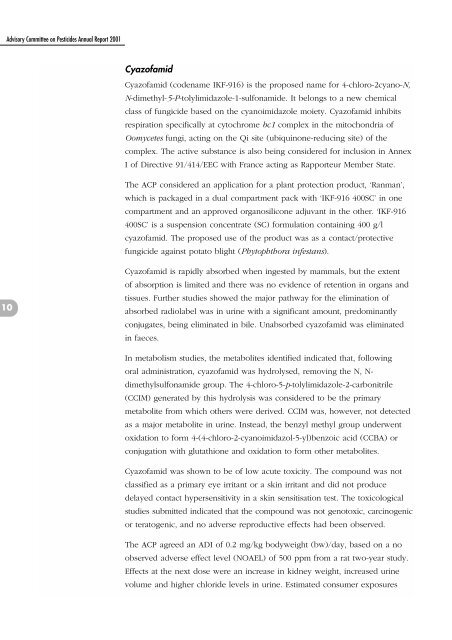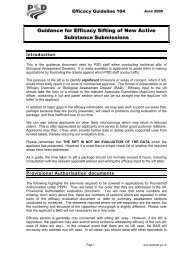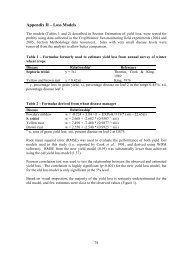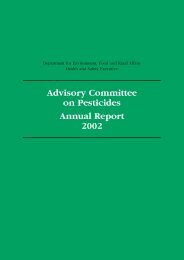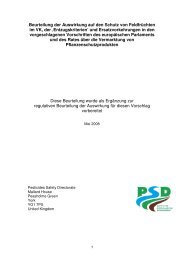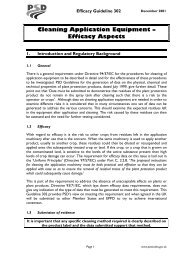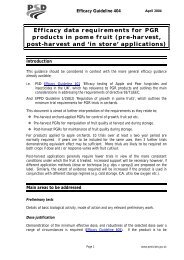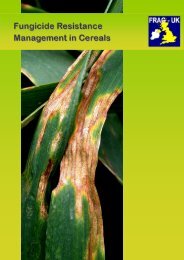Advisory Committee on Pesticides Annual Report 2001
ACP Annual Report 2001 - Pesticides Safety Directorate
ACP Annual Report 2001 - Pesticides Safety Directorate
Create successful ePaper yourself
Turn your PDF publications into a flip-book with our unique Google optimized e-Paper software.
<str<strong>on</strong>g>Advisory</str<strong>on</strong>g> <str<strong>on</strong>g>Committee</str<strong>on</strong>g> <strong>on</strong> <strong>Pesticides</strong> <strong>Annual</strong> <strong>Report</strong> <strong>2001</strong><br />
Cyazofamid<br />
Cyazofamid (codename IKF-916) is the proposed name for 4-chloro-2cyano-N,<br />
N-dimethyl-5-P-tolylimidazole-1-sulf<strong>on</strong>amide. It bel<strong>on</strong>gs to a new chemical<br />
class of fungicide based <strong>on</strong> the cyanoimidazole moiety. Cyazofamid inhibits<br />
respirati<strong>on</strong> specifically at cytochrome bc1 complex in the mitoch<strong>on</strong>dria of<br />
Oomycetes fungi, acting <strong>on</strong> the Qi site (ubiquin<strong>on</strong>e-reducing site) of the<br />
complex. The active substance is also being c<strong>on</strong>sidered for inclusi<strong>on</strong> in Annex<br />
I of Directive 91/414/EEC with France acting as Rapporteur Member State.<br />
The ACP c<strong>on</strong>sidered an applicati<strong>on</strong> for a plant protecti<strong>on</strong> product, ‘Ranman’,<br />
which is packaged in a dual compartment pack with ‘IKF-916 400SC’ in <strong>on</strong>e<br />
compartment and an approved organosilic<strong>on</strong>e adjuvant in the other. ‘IKF-916<br />
400SC’ is a suspensi<strong>on</strong> c<strong>on</strong>centrate (SC) formulati<strong>on</strong> c<strong>on</strong>taining 400 g/l<br />
cyazofamid. The proposed use of the product was as a c<strong>on</strong>tact/protective<br />
fungicide against potato blight (Phytophthora infestans).<br />
10<br />
Cyazofamid is rapidly absorbed when ingested by mammals, but the extent<br />
of absorpti<strong>on</strong> is limited and there was no evidence of retenti<strong>on</strong> in organs and<br />
tissues. Further studies showed the major pathway for the eliminati<strong>on</strong> of<br />
absorbed radiolabel was in urine with a significant amount, predominantly<br />
c<strong>on</strong>jugates, being eliminated in bile. Unabsorbed cyazofamid was eliminated<br />
in faeces.<br />
In metabolism studies, the metabolites identified indicated that, following<br />
oral administrati<strong>on</strong>, cyazofamid was hydrolysed, removing the N, N-<br />
dimethylsulf<strong>on</strong>amide group. The 4-chloro-5-p-tolylimidazole-2-carb<strong>on</strong>itrile<br />
(CCIM) generated by this hydrolysis was c<strong>on</strong>sidered to be the primary<br />
metabolite from which others were derived. CCIM was, however, not detected<br />
as a major metabolite in urine. Instead, the benzyl methyl group underwent<br />
oxidati<strong>on</strong> to form 4-(4-chloro-2-cyanoimidazol-5-yl)benzoic acid (CCBA) or<br />
c<strong>on</strong>jugati<strong>on</strong> with glutathi<strong>on</strong>e and oxidati<strong>on</strong> to form other metabolites.<br />
Cyazofamid was shown to be of low acute toxicity. The compound was not<br />
classified as a primary eye irritant or a skin irritant and did not produce<br />
delayed c<strong>on</strong>tact hypersensitivity in a skin sensitisati<strong>on</strong> test. The toxicological<br />
studies submitted indicated that the compound was not genotoxic, carcinogenic<br />
or teratogenic, and no adverse reproductive effects had been observed.<br />
The ACP agreed an ADI of 0.2 mg/kg bodyweight (bw)/day, based <strong>on</strong> a no<br />
observed adverse effect level (NOAEL) of 500 ppm from a rat two-year study.<br />
Effects at the next dose were an increase in kidney weight, increased urine<br />
volume and higher chloride levels in urine. Estimated c<strong>on</strong>sumer exposures


